"Anatomy" of home acoustic systems: electrostats. Ode to smooth frequency response, passion for the price, DIY capabilities
Developing a cycle about the criteria for the selection of acoustic systems, I decided to continue the narration with a story about radiators. Each type will be dedicated to a separate material, in this post I will talk about electrostatic acoustic systems.
Electrostatic systems stand apart due to their low prevalence, high cost, as well as unique characteristics. Those who have heard the electrostatic acoustics, know that the accuracy of sound transmission in such systems is significantly higher than that of most other speaker systems.
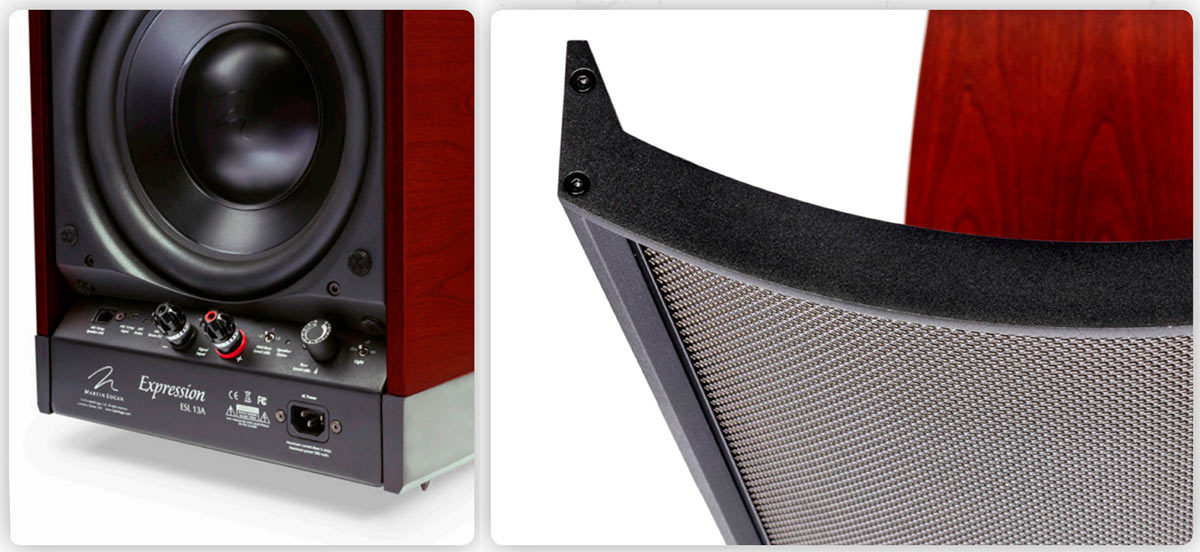
Appearing in the 20s of the last century, the design of electrostatics evolved and is currently considered one of the most effective for accurate sound transmission (especially in the mid and high frequencies).
The physical principle on which the work of electrostatics is based is quite simple. Sound frequency oscillations are created by a conductive ultrathin (from 15 to 3 microns) membrane (usually with high resistance), to which a high (up to several kV) voltage is applied.
')
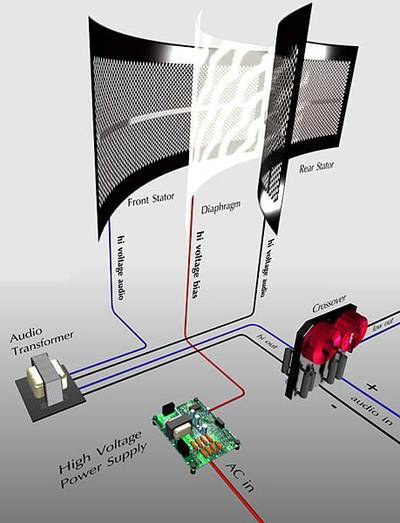
The membrane, interacting with the electric field of the stators (to which a high-voltage sound signal is supplied with a different polarity for each stator), emits sound waves. As stators, in most cases, perforated metal sheets (steel or aluminum) or wire are used, the membrane is made of ultrathin synthetic films. The principle makes it possible to reduce distortions to vanishingly small quantities and to obtain an almost perfectly smooth frequency response.
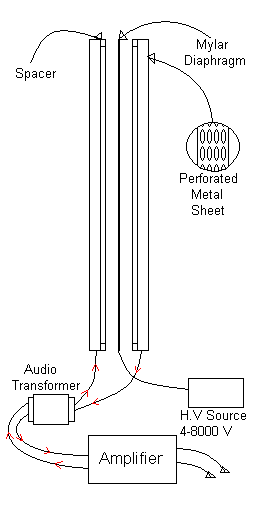
Despite the seeming simplicity, the technological implementation of the principles of electrostatic acoustics is hard to take root in mass production. Manufacturers of such acoustics (not counting headphones) can literally be counted on the fingers of two hands. The reasons for the low interest of large players in the audio market to electrostats are many, the main ones are as follows: an expensive membrane, high assembly requirements, the need to use amplifiers with an output transformer, or the use of a transformer in an AC design. As a consequence of all the above, the cost of the AU becomes worthy of description in Krylov's fables.

A big problem for electrostatic systems is the reproduction of low ones. As for the full sound in the low and mid-bass range, a huge (several square meters) area of the radiator is necessary. To solve this problem without increasing the membrane area, electrostatics are equipped with additional electrodynamic emitters and, accordingly, crossovers to separate the bands.
Most sources agree that the principle of operation of electrostatic emitters is almost the same age as electroacoustics, as an area of physical knowledge, and appeared at the end of the 19th century. For the first time such a device was demonstrated at the Paris Electric Exhibition in 1881.

Attempts to create an electrostatic speaker began even before the Great (First World War). Since the 1920s, it has been known to use commercial single-ended (with 1 stator) electrostatic stations for sounding concert venues, conference rooms, open platforms for public events, and also for playing music in expensive silent theaters. Such speakers were used with the first tube amplifiers.

The most successful commercially (in the 20s - 30s) were the first two-stroke electrostatic speakers created by the German engineer Hans Vogt.
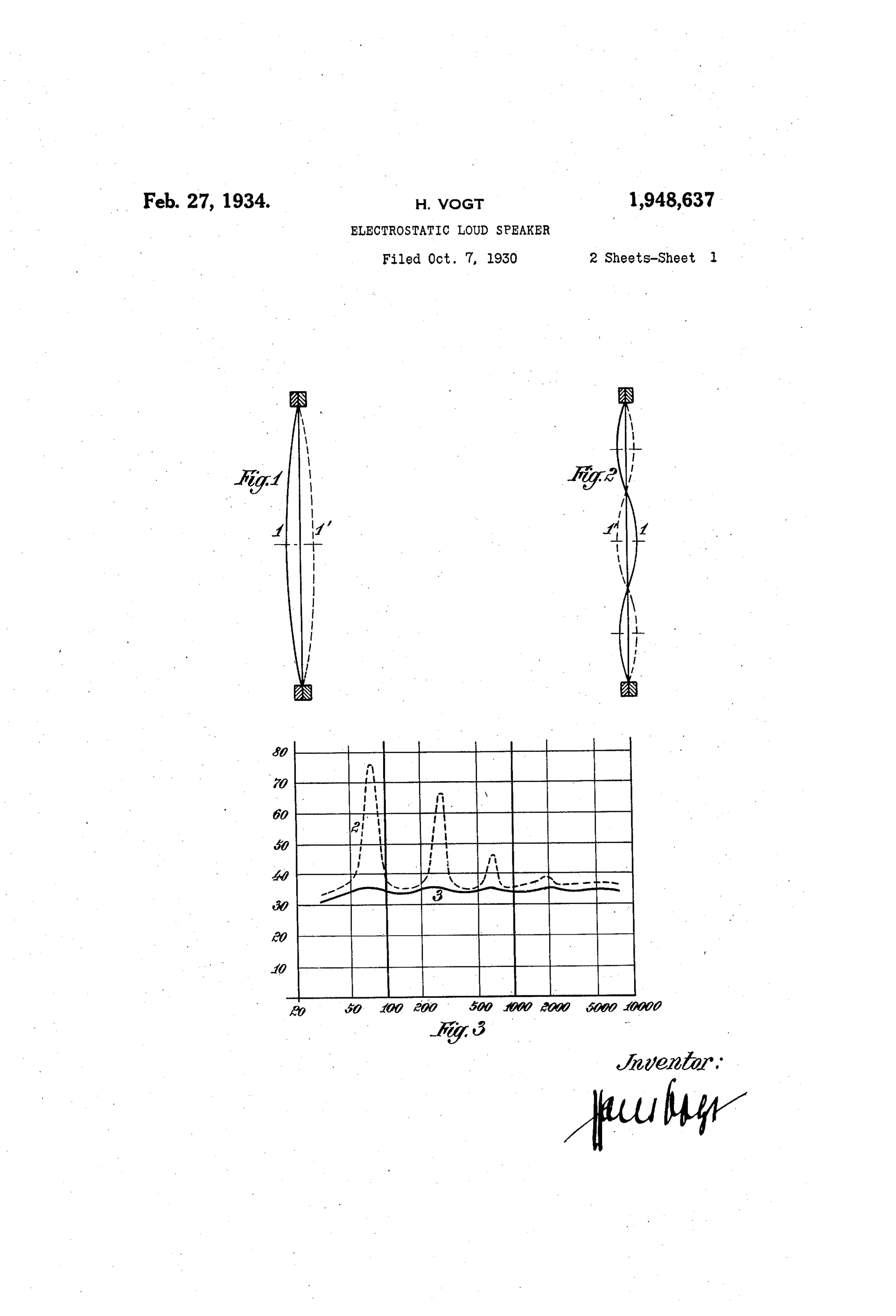
These speakers were limitedly used in movie theaters for sound films until the end of the 30s. The main problem of speakers of this type at that time was low survivability, due to the use of low-resistance aluminum foil (they also experimented with gold foil and a number of other conductors), which had a tendency to burn during breakdown. The development of ferromagnets (respectively, electrodynamic loudspeakers), and the lack of effective materials for creating membranes, stopped the further development of electrostatics up to the 50s.
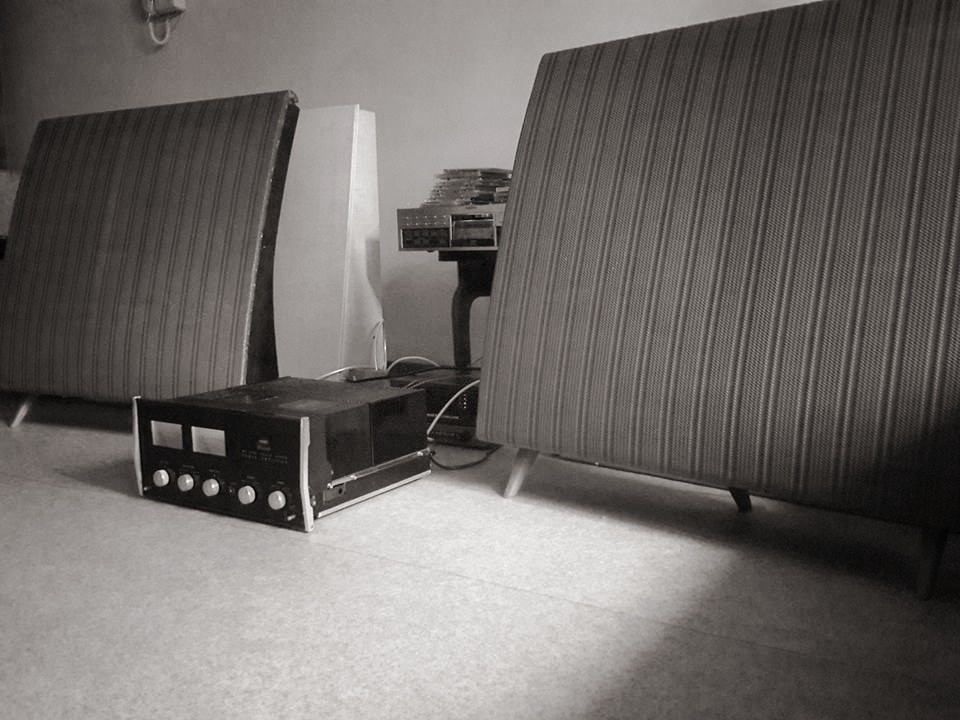
The next epochal moment in the development of electrostatics was the appearance of lavsan, which was the most suitable material for the membrane. In 1953, Arthur Jansen received a patent for a new type of electrostatic emitter, and already in 1957, the longest-lived electrostat, the QUAD ESL57, appeared, the production of which lasted until 1981. Original designs offered Williamson and Reed.

A real breakthrough for electrostatic acoustics was the startup Gale Martin Sanders and Ron Logan Sutherland, who, “sculpted” in the garage electrostatic acoustics of the original design, dragged it to the Light of God and showed to honest people at the Chicago CES in 1982.

The result was impressive: the invention was the winner of the exhibition, and the partners, developers to this day earn serial production of electrostatics. By the way, the company Martin Logan is deservedly considered one of the best manufacturers of such speakers.
One of the main advantages of electrostatic speakers is the vanishingly low level of distortion. THD is not more than 0.5%, IMD does not exceed 1%, there are practically no phase distortions. Another impressive advantage is that the non-uniformity of the frequency response of modern electrostatos is within ± 3 dB. Wide frequency range (on average from 100 Hz to 40 000 kHz). AC with a large area of the membrane can successfully cope with midbass and low.
With the exception of a relatively low sensitivity and sometimes a limited lower threshold of the frequency range in terms of sound reproduction, electrostatic speakers have practically no drawbacks and are comparable, perhaps, only with ionophones.
The active combined (ES + dynamic bass) speaker Martin Logan Renaissance ESL 15A has ideal characteristics for modern electrostats.
The simplicity of the principle of operation of electrostatic loudspeakers opens up opportunities for self-development. I have doubts that it is easy to independently collect electrostatics that reach the level of serial samples, but people whose hands grow from their bodies usually do not waste time searching for easy ways.
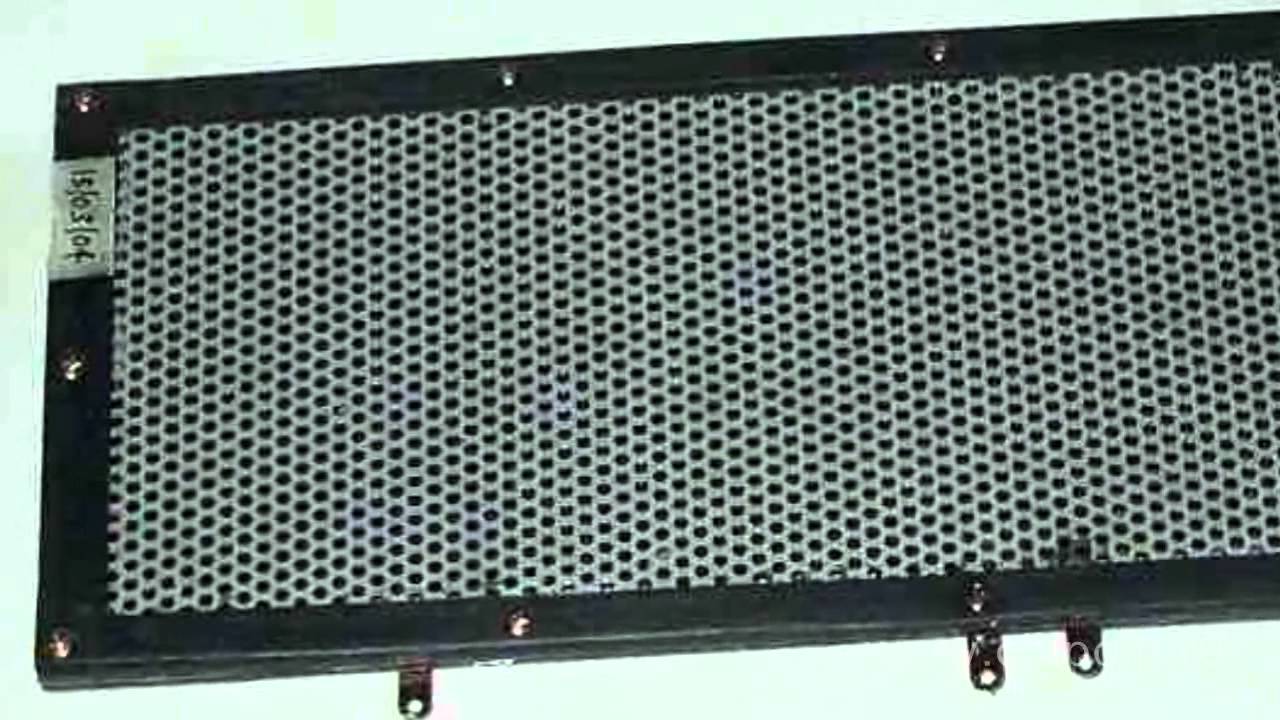
Anyway, the garage experience of Gale Martin Sanders and Ron Logan Sutherland shows the practical feasibility of such a bold idea. Who knows, maybe in 10 years the console will trade in electrostats of one of the readers of these lines.
User KRIdas gives very valuable recommendations for the independent creation of electrostatic speakers in a conference on xbit .
A few important points about which KRIdas wrote:
Our catalog contains several electrostatic speakers. Our experts have tried to choose the best of what exists today on the market for these uncompromising devices. The quality will satisfy even the most demanding audiophiles. I warn you - prices do not just bite, but strive to bite off your hand along with a credit card.
Electrostatic systems stand apart due to their low prevalence, high cost, as well as unique characteristics. Those who have heard the electrostatic acoustics, know that the accuracy of sound transmission in such systems is significantly higher than that of most other speaker systems.

Appearing in the 20s of the last century, the design of electrostatics evolved and is currently considered one of the most effective for accurate sound transmission (especially in the mid and high frequencies).
The simple principle is complex technology.
The physical principle on which the work of electrostatics is based is quite simple. Sound frequency oscillations are created by a conductive ultrathin (from 15 to 3 microns) membrane (usually with high resistance), to which a high (up to several kV) voltage is applied.
')

The membrane, interacting with the electric field of the stators (to which a high-voltage sound signal is supplied with a different polarity for each stator), emits sound waves. As stators, in most cases, perforated metal sheets (steel or aluminum) or wire are used, the membrane is made of ultrathin synthetic films. The principle makes it possible to reduce distortions to vanishingly small quantities and to obtain an almost perfectly smooth frequency response.

Despite the seeming simplicity, the technological implementation of the principles of electrostatic acoustics is hard to take root in mass production. Manufacturers of such acoustics (not counting headphones) can literally be counted on the fingers of two hands. The reasons for the low interest of large players in the audio market to electrostats are many, the main ones are as follows: an expensive membrane, high assembly requirements, the need to use amplifiers with an output transformer, or the use of a transformer in an AC design. As a consequence of all the above, the cost of the AU becomes worthy of description in Krylov's fables.

A big problem for electrostatic systems is the reproduction of low ones. As for the full sound in the low and mid-bass range, a huge (several square meters) area of the radiator is necessary. To solve this problem without increasing the membrane area, electrostatics are equipped with additional electrodynamic emitters and, accordingly, crossovers to separate the bands.
A brief history of electrostatics from the 19th century to the present day
Most sources agree that the principle of operation of electrostatic emitters is almost the same age as electroacoustics, as an area of physical knowledge, and appeared at the end of the 19th century. For the first time such a device was demonstrated at the Paris Electric Exhibition in 1881.

Attempts to create an electrostatic speaker began even before the Great (First World War). Since the 1920s, it has been known to use commercial single-ended (with 1 stator) electrostatic stations for sounding concert venues, conference rooms, open platforms for public events, and also for playing music in expensive silent theaters. Such speakers were used with the first tube amplifiers.

The most successful commercially (in the 20s - 30s) were the first two-stroke electrostatic speakers created by the German engineer Hans Vogt.

These speakers were limitedly used in movie theaters for sound films until the end of the 30s. The main problem of speakers of this type at that time was low survivability, due to the use of low-resistance aluminum foil (they also experimented with gold foil and a number of other conductors), which had a tendency to burn during breakdown. The development of ferromagnets (respectively, electrodynamic loudspeakers), and the lack of effective materials for creating membranes, stopped the further development of electrostatics up to the 50s.

The next epochal moment in the development of electrostatics was the appearance of lavsan, which was the most suitable material for the membrane. In 1953, Arthur Jansen received a patent for a new type of electrostatic emitter, and already in 1957, the longest-lived electrostat, the QUAD ESL57, appeared, the production of which lasted until 1981. Original designs offered Williamson and Reed.

A real breakthrough for electrostatic acoustics was the startup Gale Martin Sanders and Ron Logan Sutherland, who, “sculpted” in the garage electrostatic acoustics of the original design, dragged it to the Light of God and showed to honest people at the Chicago CES in 1982.

The result was impressive: the invention was the winner of the exhibition, and the partners, developers to this day earn serial production of electrostatics. By the way, the company Martin Logan is deservedly considered one of the best manufacturers of such speakers.
Virtues
One of the main advantages of electrostatic speakers is the vanishingly low level of distortion. THD is not more than 0.5%, IMD does not exceed 1%, there are practically no phase distortions. Another impressive advantage is that the non-uniformity of the frequency response of modern electrostatos is within ± 3 dB. Wide frequency range (on average from 100 Hz to 40 000 kHz). AC with a large area of the membrane can successfully cope with midbass and low.
With the exception of a relatively low sensitivity and sometimes a limited lower threshold of the frequency range in terms of sound reproduction, electrostatic speakers have practically no drawbacks and are comparable, perhaps, only with ionophones.
The active combined (ES + dynamic bass) speaker Martin Logan Renaissance ESL 15A has ideal characteristics for modern electrostats.
- Minimum recommended power, W: 20
- Maximum power, W: 700
- Sensitivity: 92 dB
- Impedance: 4 ohms
- Frequency range: 22-21000 Hz (± 3 dB)
- Crossover frequency: 300 Hz
- THD: less than 0.1%
- IMD: less than 0.5%
disadvantages
- Astronomical cost: most electrostatos cost a lot of money. It is noteworthy that there are one Russian and several Chinese manufacturers with relatively inexpensive systems (up to 60,000 rubles), but their characteristics are comparable with electrodynamic and isodynamic for the same money;
- Relatively low sensitivity: rarely rises above 85-87 dB, not even all top models of electrostatos can boast higher performance. 92 - 95 dB can be considered an almost unattainable ceiling;
- Dipole nature of the sound: limits the freedom of placement of speakers, does not allow to place the system along the wall;
- Limiting the maximum volume limits to the gap between the membrane and the stators;
- Demanding of amplification, required UMZCH with output transformer or built-in transformer provided by the design of the AU;
- Relatively narrow sound directivity;
- Attracting dust reduces the aesthetic appearance;
- For non-combined speakers with low-frequency speakers, electrostatic speakers are characterized by a lack of a low-frequency spectrum;
DIY electrostatics are not a myth, but a fact
The simplicity of the principle of operation of electrostatic loudspeakers opens up opportunities for self-development. I have doubts that it is easy to independently collect electrostatics that reach the level of serial samples, but people whose hands grow from their bodies usually do not waste time searching for easy ways.

Anyway, the garage experience of Gale Martin Sanders and Ron Logan Sutherland shows the practical feasibility of such a bold idea. Who knows, maybe in 10 years the console will trade in electrostats of one of the readers of these lines.
User KRIdas gives very valuable recommendations for the independent creation of electrostatic speakers in a conference on xbit .
A few important points about which KRIdas wrote:
- You must use a film with a thickness of no more than 30 microns (it is better to fall in the range from 3 to 15 microns)
- As perforated gratings, you can use steel or aluminum sheets with a hole diameter of 3 mm and a pitch of 4 mm.
- the gaps between the membrane and the stators should be about 3 mm
Quite a few jeans
Our catalog contains several electrostatic speakers. Our experts have tried to choose the best of what exists today on the market for these uncompromising devices. The quality will satisfy even the most demanding audiophiles. I warn you - prices do not just bite, but strive to bite off your hand along with a credit card.
Curious
www.pult.ru/product/64327.htm
www.pult.ru/product/final-sound-model-300i-pl-fs-silver-black
www.pult.ru/product/napolnaya-akustika-martin-logan-classic-esl-9-walnut
www.pult.ru/product/final-sound-model-600i-pl-fs-silver-black
www.pult.ru/product/napolnaya-akustika-martin-logan-impression-esl-11a-gloss-white
www.pult.ru/product/napolnaya-akustika-martin-logan-expression-esl-13a-gloss-black
www.pult.ru/product/napolnaya-akustika-martin-logan-clx-art-high-gloss-natural-cherry
www.pult.ru/product/napolnaya-akustika-martin-logan-neolith-deep-sea-blue
www.pult.ru/product/final-sound-model-1000i-pl-fs-silver-black
www.pult.ru/product/napolnaya-akustika-martin-logan-renaissance-esl-15a-desert-silver
www.pult.ru/product/60908.htm
www.pult.ru/product/final-sound-model-1000i-pl-fs-silver-black
www.pult.ru/product/final-sound-model-300i-pl-fs-silver-black
www.pult.ru/product/napolnaya-akustika-martin-logan-classic-esl-9-walnut
www.pult.ru/product/final-sound-model-600i-pl-fs-silver-black
www.pult.ru/product/napolnaya-akustika-martin-logan-impression-esl-11a-gloss-white
www.pult.ru/product/napolnaya-akustika-martin-logan-expression-esl-13a-gloss-black
www.pult.ru/product/napolnaya-akustika-martin-logan-clx-art-high-gloss-natural-cherry
www.pult.ru/product/napolnaya-akustika-martin-logan-neolith-deep-sea-blue
www.pult.ru/product/final-sound-model-1000i-pl-fs-silver-black
www.pult.ru/product/napolnaya-akustika-martin-logan-renaissance-esl-15a-desert-silver
www.pult.ru/product/60908.htm
www.pult.ru/product/final-sound-model-1000i-pl-fs-silver-black
Source: https://habr.com/ru/post/401965/
All Articles